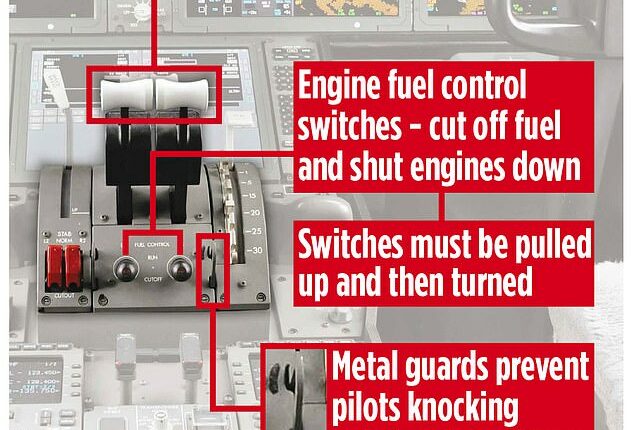Air India was warned about wrongly installed fuel switches more than six years before a crash that killed 260 people, it was revealed yesterday.
Investigators are probing how two fuel switches in the cockpit of Air India Flight 171 were turned off shortly after take off, resulting in a catastrophic loss of power and the aircraft crashing to the ground.
The switches’ ‘locking feature’ meant pilots had to lift them up before changing their position.
But a preliminary report by India’s Aircraft Accident Investigation Bureau (IAAB) said yesterday that in December 2018 the US air regulator Federal Aviation Administration (FAA) warned airlines that fuel switches had been installed in some Boeing 737s ‘with the locking feature disengaged’.
‘If the locking feature is disengaged, the switch can be moved between the two positions without lifting the switch during transition, and the switch would be exposed to the potential of inadvertent operation,’ the FAA warned in a Special Airworthiness Information Bulletin.
‘Inadvertent operation of the switch could result in an unintended consequence, such as an in-flight engine shutdown.’
It recommended airlines inspect the switches, including ‘whether the fuel control switch can be moved between the two positions without lifting up the switch’.
Air India has suggested such inspections were not carried out because the FAA’s bulletin was ‘advisory and not mandatory’.

An infographic shows the location of the two fuel-control switches, which moved to the ‘cut-off’ position shortly after takeoff, starving the engines of fuel and triggering total power loss

The burnt-out fuel control switches recovered by investigators from the cockpit were found in the ‘run’ position, according to the India’s government’s Aircraft Accident Investigation Bureau
But the report also highlighted the aircraft’s maintenance records show its throttle control module – the part of the cockpit which includes the two fuel switches – was replaced in 2019 and 2023.
Each time, the decision was not linked to the switches and no defects with them were reported in the last two years, it added.
An Air India spokesman said: ‘Air India stands in solidarity with the families and those affected by the AI171 accident. We continue to fully co-operate with the Aircraft Accident Investigation Bureau and other authorities as their investigation progresses.’
It comes as grieving relatives of victims of the crash have voiced their anguish amid the deepening mystery over how the jet’s fuel supply was switched off seconds before the disaster.
The IAAB report yesterday revealed how just seconds after take-off, both of the Boeing 787 Dreamliner’s fuel-control switches moved to the ‘cut-off’ position, starving the engines of fuel and triggering total power loss.
One pilot was heard on the aircraft’s voice recorder asking his fellow pilot why he had cut off the fuel supply – only for him to reply that he had not done so.
Moments later – with not enough time for one of the engines to restart – the plane crashed into a medical hostel. Some 241 passengers and crew and 19 people on the ground died. Vishwash Kumar Ramesh, 40, a businessman from Leicester, who was sitting in seat 11A, was the sole survivor.
Dr Mario Donadi, a friend of Dr Prateek Joshi, a radiologist at the Royal Derby Hospital, who died alongside his wife and three children, described the report as ‘shocking’ and a ‘slap in the face’.

The crash near Ahmedabad, India, killed 260 people last month, including 52 British nationals


Air India has said that the flight’s captain, Sumeet Sabharwal (left) had over 10,000 hours experience of flying wide-body or larger aircrafts – while his co-pilot Clive Kunder also had over 3,400 hours of flying experience
‘How [can] something so trivial [as] a simple switch being deactivated lead to such a loss of life, of huge dreams?’,’ he told BBC Radio 4’s Today programme.
Bhaval Shah, a family friend of victim Kinal Mistry, 24, said: ‘If these switches can’t be turned off easily and if no software glitch could have been responsible, then it is deliberate, isn’t it? Then it’s sabotage or suicide.’
The 15-page report by India’s Aircraft Accident Investigation Bureau (AAIB) has thrown a spotlight on the two small fuel switches which were located just below the thrust levers in the cockpit.
The 12-year-old jet, bound for Gatwick airport, took off within its ‘allowable’ weight limits, including 54,200kg of fuel, the report stated. But three seconds later, the fuel switches were abruptly moved from the ‘run’ position to the ‘cut-off’ position.
Investigators say the switches have a locking feature which is designed to prevent them being accidentally activated. A pilot has to pull up the switch before moving it to its new position. Protective guard brackets further shield them from accidental bumps.
‘It would be almost impossible to pull both switches with a single movement of one hand and this makes accidental deployment unlikely,’ a Canada-based air accidents investigator, who wanted to remain anonymous, told the BBC.
The two switches were flipped one second apart, the report said – roughly the time it would take to shift one and then the other, added US aviation expert John Nance.
The report highlights the chilling moment when one pilot discovers that either a catastrophic mistake, fault or deliberate act of sabotage has taken place. ‘In the cockpit voice recording, one of the pilots is heard asking the other why did he cut off. The other pilot responded that he did not do so.’
In a sign of growing tensions, a pilots union said the ‘tone and direction of the investigation suggested a bias toward pilot error’.
Captain Sam Thomas, from the Airline Pilots’ Association of India, said the organisation was ‘surprised at the secrecy surrounding these investigations’ and claimed ‘suitably qualified personnel were not taken on board for the probe’.
Civil aviation minister Ram Mohan Naidu urged the public to ‘wait for the final report’, adding: ‘We care for the welfare and the well-being of pilots so let’s not jump to any conclusions at this stage.’
Imtiyaz Ali, whose brother, sister-in-law and their two children died in the crash, was disappointed by the findings. ‘Other than the pilots’ final conversation, there’s nothing in it that really points to what caused the crash. We want to know exactly what happened.
‘It won’t change anything for us now, we continue grieving – just as we have since that day. But at least we’ll have some answers.’
Rafiq Dawood, whose son Faizan Rafiq, 25, died after moving to the UK five years ago, said: ‘We don’t know about the fuel switch or other technical details. The fact is that we have lost our son.’
Deepti Sawhney, who lost three family members, told news channel NDTV: ‘We must have a free, fair and transparent investigation. There are a lot of heavyweights involved – Air India, Boeing – who will want to save their skin. The families must get the truth.’
Badasab Syed, 59, whose brother, sister-in-law and their two children died, said: ‘The report mentions the pilots discussing who turned off fuel and a possible issue with the fuel control switch. We don’t know what that means. Was it avoidable?’

The tailend of Air India flight 171 is pictured after it crashed in a residential area near the airport in Ahmedabad on June 12, 2025
The report reveals that in the seconds before the crash, the pilots returned the fuel switches to ‘run’ and two systems tried to ‘relight’ both engines. But it was too late – 11 seconds before impact, one pilot transmitted: ‘Mayday, Mayday, Mayday.’
Using photographs and diagrams, the findings detail how the plane first hit trees and a chimney before smashing into the BJ Medical College hostel and five adjoining buildings just under a mile from the runway.
The tail section and landing gear were found embedded in one building. The rest of the wreckage was spread over an area of 1,000ft by 400ft.
Pilots Captain Sumeet Sabharwal, 56, had clocked up 15,638 flying hours, while Clive Kunder, 32, had 3,403. Mr Kunder was flying the Dreamliner, while Mr Sabharwal was monitoring him – although it is unclear from the report who said what during the recording. A final report is due to be released next year.
Boeing said: ‘Our thoughts remain with the loved ones of the passengers and crew on board
Air India Flight 171, as well as everyone affected on the ground in Ahmedabad. We continue to support the investigation.’





